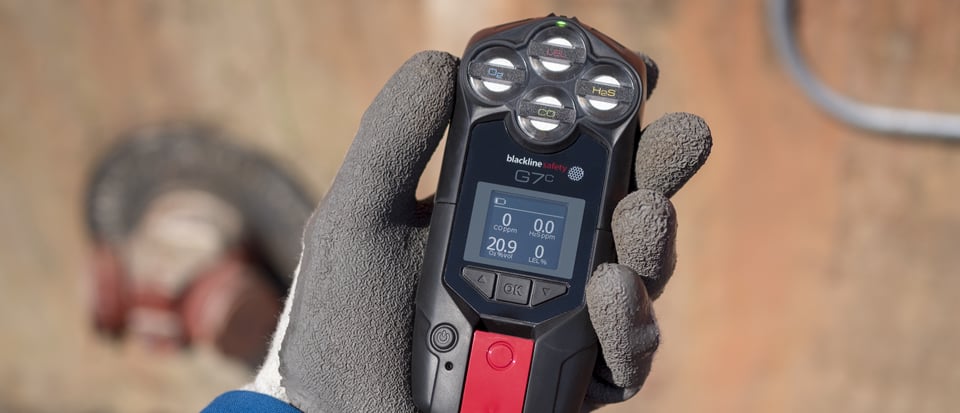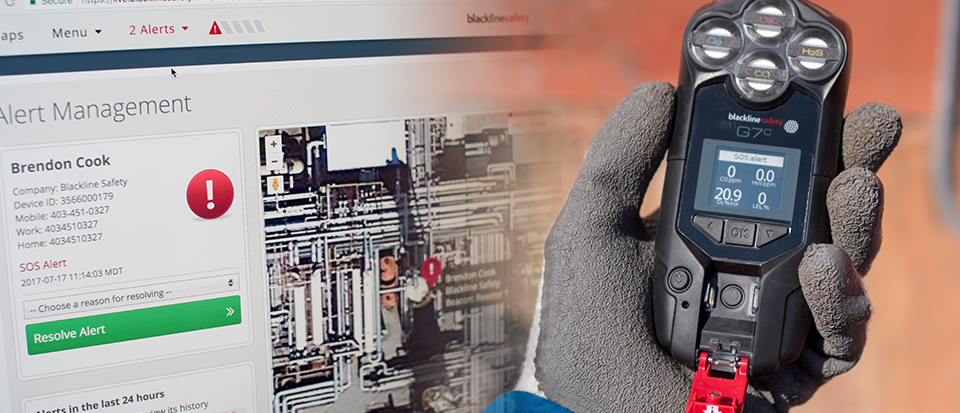Blackline Safety is a technology leader driving innovation in the industrial workforce through IoT (Internet of Things). With connected safety devices and predictive analytics, Blackline enables companies to drive towards zero safety incidents and improved operational performance. Blackline provides wearable devices, personal and area gas monitoring, cloud-connected software and data analytics to meet demanding safety challenges and enhance overall productivity for organizations with coverage in more than 100 countries. Armed with cellular and satellite connectivity, Blackline provides a lifeline to tens of thousands of people, having reported over 200 billion data-points and initiated over seven million emergency alerts. For more information, visit BlacklineSafety.com and connect with us on Facebook, Twitter, LinkedIn and Instagram.
World's First BS8484: 2016 Certified Gas Detector
Blackline Safety, Leader in Connected Gas Detection & Lone Worker Safety
April 10, 2018
Blackline’s G7c is the world’s only gas detector and lone worker monitor certified to BS8484:2016, the standard that defines the requirements for lone worker safety monitoring products and service providers, ensuring that businesses are competent, and the functionality of lone worker devices is fit-for-purpose.

Lone worker legislation
Lone workers are employees working out of sight and sound of others for periods of time throughout their day up to entire shifts. Without qualified people around to help or despatch responders, these individuals are particularly vulnerable to injury or a health event. Lone working presents a unique challenge for employers that requires assessment of risks and hazards, efforts to mitigate them, plus a program to ensure lone worker well-being around the clock.
Lone working in the United Kingdom
The United Kingdom is one of the most successful nations when it comes to workplace safety, in large part due to formal parameters outlining the responsibilities of employers. Stringent regulations and adhered-to industry best practices help ensure that employees can return home safely at the end of the day. BS8484 defines the industry-leading code of practice for lone worker equipment and monitoring services in the United Kingdom. “Our stringent safety regulations help to ensure that we consistently achieve success in keeping people safe while at work,” said Gavin Boorman, Managing Director at Blackline Safety Europe, Ltd., a fully-owned subsidiary of Blackline Safety Corp. “The latest BS8484: 2016 standard underscores the UK’s safety leadership by providing lone worker product and service providers with a code of practice that allows the despatch of a police Level 1 response.” In particular, BS8484 enables certified service suppliers to bring the highest level of emergency response (Level 1), not available through the potentially slow 999 service.
Innovation drives regulation
The introduction of Blackline’s G7c disrupted the safety monitoring and gas detection arenas by integrating 3G connectivity and a host of industry-first capabilities, to enable more efficient and reliable lone worker monitoring. The risk that an employee's call for help could go unanswered is mitigated by connecting workers directly with live monitoring personnel, from wherever they may be working.

Connectivity is also necessary to ensure the fastest possible emergency response. The live monitoring team follows tailored emergency response protocols and when required, escalating to the highest levels of police, ambulance or fire — only allowable using a BS8484 certified solution. G7c is the only combination lone worker monitoring and gas detection product currently on the market that is BS8484: 2016 certified.
Optimized emergency response
Relevant lone worker policy plus innovative employee-worn technology can mitigate the potential risks that lone workers face every day. G7c features automatic fall and no-motion alerts, plus an automated check-in process — should a worker fail to confirm their safety after a set period of time, G7c automatically communicates the alert to monitoring personnel, empowered to despatch the necessary emergency response, up to and including police. A manual SOS latch can easily be pulled in the event that a worker needs to communicate with their monitoring team — should they be faced with a threatening confrontation or even just locked out of their vehicle in the cold. Worker location and safety status are easily viewed on a live map, so responders know exactly where to go.
Lone worker checklist
Explore our Lone Worker Technology Checklist to discover how best to meet the safety needs of your lone workers.
| Real-time wireless communication | Continuous, bi-directional communication that ensures employees can work confidently knowing their safety is being monitored |
| Automatic fall detection | Detects slips, trips and falls as differentiated from other activities |
| Automatic no-motion detection | Detects when an employee has not moved for a pre-configured amount of time |
| Scheduled automated check-ins | Confirms employee well being |
| Gas detection | Detects toxic, asphyxiant and explosive gas leaks |
| Manual SOS feature | Allows employees to call for help manually, without looking or potentially pressing the wrong button |
| Intrinsically safe design | For hazardous locations, electronic devices must be intrinsically safety as to not trigger a potentially explosive atmosphere |
| Durability and ingress protection | A device should be rugged and protected from water and dust |
| Location technology | Assisted GPS technology provides accurate positioning outdoors, while location beacons provide accurate indoor locations where GPS signals may be weak or not available |
| Floor and site plans | The location of employees working indoors should be mapped in context of their surroundings |
| Web-based monitoring portal | Monitoring software should be web-based and not require software installation |
| Two-way voice communication | Monitoring personnel should be able to communicate with lone workers via speakerphone |
| Employee messaging | Monitoring personnel should be able to communicate with lone workers via two-way messaging |
| Evacuation management | Monitoring personnel should be able to trigger and monitor an evacuation as its happening |
| Employee mass notification | Employees should be notified to hazards, events and even weather alerts |
| Advanced configurability | Lone worker devices must be configurable for a broad range of scenarios and worker roles |
Can we help you?
Let us know if we can help you explore your scenario to determine how G7 solutions can help to increase your teams' level of safety while increasing productivity. Reach out to our team at Blackline Safety anytime — we have your back.

Gavin is the Managing Director for Blackline Safety Europe, and has been active in the world of safety and gas detection for more than 25 years. He has worked with companies such as City Technology, Det-Tronics, Crowcon, Alphasense, BW Technologies and GfG Europe. Gavin holds a BSc. In Applied Chemistry from Leicester Polytechnic (now DeMontfort University).
Get In Touch
Let’s start a discussion about your safety challenges and needs.
Related Blog Posts
EXO Detects Underground Danger
April 04, 2025
It started with a strange sight—bubbling groundwater just outside the offices of Blackline Safety channel partner Aegis Safety in Brisbane,...
When Seconds Matter: Protecting Emergency Responders and the Public from Radiation
March 28, 2025
Picture the scene: a firefighter races to a dumpsite unaware that improperly disposed of radioactive materials are present. The Geiger counter at the...
Real-life Incident: Lieutenant Anderson II’s Story – The Silent Killer
February 25, 2025
‘The absolute worst atmosphere I've seen': How G6 alerted first responders to lethal CO levels The scene that greeted firefighters as they...


